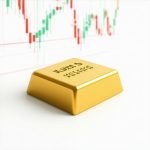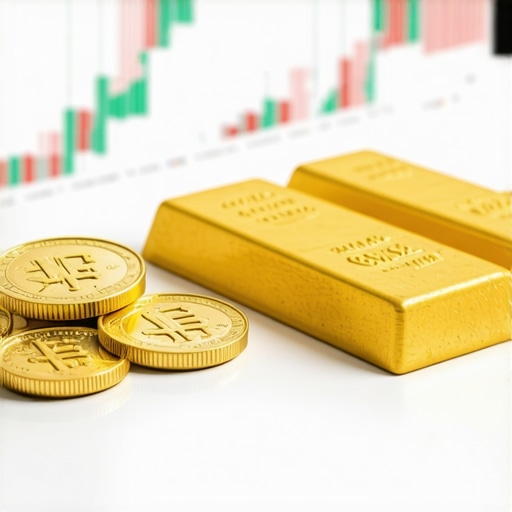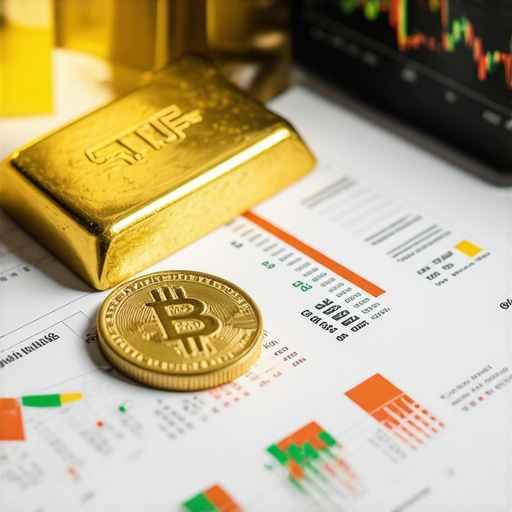Understanding Gold Investments: A Beginner’s Guide
Gold has always been a symbol of wealth and security, making it a popular asset for both seasoned investors and beginners. As economic uncertainties loom, many individuals consider gold investments as a means to diversify their portfolios and secure their financial futures. In this guide, we will explore five types of gold investments that beginners should consider, each offering unique benefits and potential risks.
1. Physical Gold: Coins and Bars
One of the most tangible forms of gold investment is through physical gold, such as coins and bars. These items can be bought from reputable dealers and stored securely at home or in a bank vault. Physical gold allows investors to hold their wealth in a form that is not subject to digital or economic fluctuations. However, it’s essential to consider storage costs and insurance when opting for this investment type.
2. Gold ETFs: A Convenient Alternative
Exchange-Traded Funds (ETFs) are another excellent option for beginners looking to invest in gold without the hassle of physical storage. Gold ETFs are designed to track the price of gold and can be traded on stock exchanges just like regular stocks. They offer liquidity and can be a low-cost way to gain exposure to gold. For those interested in exploring the benefits of gold ETFs, check out this comprehensive guide on selecting the right fund for your financial goals.
3. Gold Mining Stocks: Investing in Companies
Investing in gold mining stocks is another way to gain exposure to the gold market. By purchasing shares in companies that explore and mine gold, investors can benefit from potential company growth and rising gold prices. However, investing in mining stocks carries inherent risks, including operational challenges and market volatility. For a deeper understanding of this investment strategy, read this article on evaluating mining stocks.
4. Gold Mutual Funds: Pooling Resources
Gold mutual funds pool money from multiple investors to purchase a diversified portfolio of gold-related assets, including stocks of mining companies and gold bullion. This type of investment can provide beginners with a diversified exposure to the gold market without requiring extensive knowledge of individual stocks. To learn more about how mutual funds can fit into your gold investment strategy, explore this insightful post.
5. Gold Futures: Advanced Trading
For those looking to engage in more advanced trading, gold futures contracts offer a way to bet on the future price of gold. These contracts obligate the buyer to purchase gold at a predetermined price at a specific date in the future. While this can lead to high profits, it also comes with significant risks. Beginners should approach this investment type with caution and ideally seek guidance on futures trading before diving in.
Understanding Gold ETFs: Flexibility and Accessibility
Gold ETFs, or Exchange-Traded Funds, represent a popular choice for investors seeking flexibility in their gold investments. Unlike physical gold, which requires secure storage, gold ETFs allow investors to purchase shares that represent a certain amount of gold bullion. This method not only simplifies the process of buying gold but also provides liquidity as these shares can be traded on major stock exchanges. For beginners, this can be an excellent way to enter the gold market without the complexities associated with physical ownership.
The Benefits of Gold ETFs
One of the significant advantages of investing in gold ETFs is their low expense ratios compared to mutual funds. Additionally, they typically have lower management fees, making them a cost-effective option for gaining exposure to gold. For those looking to maximize returns while minimizing costs, understanding the best strategies for gold mutual funds is essential.
How to Choose the Right Gold ETF
When selecting a gold ETF, consider factors such as the fund’s tracking performance, management fees, and the amount of physical gold held in reserve. It’s crucial to choose an ETF that closely mirrors the price movements of gold. For a comprehensive guide on selecting the right fund for your financial goals, check out this insightful post.
Gold Mutual Funds: Diversification for Beginners
Gold mutual funds are another avenue for investors looking to diversify their portfolios without directly investing in physical gold. These funds pool capital from multiple investors to invest in a mix of gold assets, such as gold bullion and mining company stocks. This approach allows beginners to gain exposure to the gold market while spreading the risk across various assets.
Why Opt for Gold Mutual Funds?
Investing in gold mutual funds offers several advantages, including professional management and diversification. As these funds are managed by experienced investors, beginners can benefit from their expertise without needing to track individual stocks or market trends closely. If you’re curious about how mutual funds can fit into your gold investment strategy, visit this article for more details.
Understanding the Risks
While gold mutual funds can be an excellent way to invest, they come with risks, including market volatility and management fees. It’s essential to evaluate the fund’s performance history and management style before investing. Additionally, beginners should consider the long-term performance of these funds, especially in relation to gold price trends. To further explore these factors, check out this analysis on demand trends that can impact investment decisions.
Conclusion: The Path to Gold Investment Success
As you embark on your journey into gold investments, it’s vital to weigh the benefits and risks of each type. Whether you choose physical gold, ETFs, or mutual funds, understanding the market dynamics and staying informed about trends will empower you to make sound investment choices. Stay tuned as we delve deeper into gold futures and other advanced investment strategies in the upcoming sections.
Gold Futures: Navigating Complex Markets
Gold futures are a compelling avenue for investors seeking to engage in more sophisticated trading strategies. Unlike traditional investments, gold futures allow traders to speculate on the future price of gold, offering the potential for significant profits. However, they also come with heightened risks due to market volatility and leverage.
Understanding Gold Futures Contracts
A gold futures contract is an agreement to buy or sell a specific amount of gold at a predetermined price on a future date. This financial instrument is traded on various exchanges, providing investors with the opportunity to capitalize on price fluctuations. For those interested in diving deeper into this topic, refer to this comprehensive overview of gold futures.
Benefits of Trading Gold Futures
One of the primary advantages of trading gold futures is the ability to leverage your investment. Traders can control a larger position with a relatively small amount of capital. This amplified exposure can lead to significant gains if the market moves in your favor. Additionally, gold futures are often used as a hedge against inflation or economic uncertainty, making them a suitable option for risk-conscious investors.
Risks Associated with Gold Futures
While the potential rewards of trading gold futures are enticing, the risks cannot be overlooked. The leverage that allows traders to control larger positions can also lead to substantial losses. It’s crucial for beginners to approach futures trading with caution, ideally seeking guidance from experienced traders or educational resources. For insights into common pitfalls in gold investing, check out this informative article.
Gold Investment Strategies: Combining Assets
As investors explore various gold investment avenues, combining different strategies can lead to a more balanced portfolio. By diversifying across physical gold, ETFs, mutual funds, and mining stocks, individuals can mitigate risks while still benefiting from the growth potential in the gold market.
The Role of Gold Mining Stocks
Investing in gold mining stocks offers a unique perspective on the gold market. As these companies are directly involved in the extraction and sale of gold, their stock prices are influenced by both gold prices and operational efficiencies. For those interested in evaluating gold mining stocks, explore this detailed analysis that outlines the factors to consider.
Blending ETFs and Mutual Funds
Integrating gold ETFs with mutual funds can enhance investment flexibility. ETFs provide quick access to the gold market, while mutual funds offer expert management and diversification. By combining these two investment vehicles, investors can benefit from the liquidity of ETFs and the stability of professionally managed funds. For more on how these funds work together, read this insightful piece.
Market Trends Influencing Gold Investments
Understanding market trends is essential for making informed gold investment decisions. Factors such as economic indicators, geopolitical tensions, and changes in currency values can all impact gold prices. Investors should stay informed about these trends to adjust their strategies accordingly.
Geopolitical Factors Affecting Gold Prices
Gold is often viewed as a safe-haven asset during times of geopolitical uncertainty. Events such as conflicts, trade disputes, or elections can drive investors toward gold, increasing its demand and price. Keeping an eye on global news and events can provide valuable insights into potential price movements. For a closer look at how gold demand trends can affect investments, visit this article.
As you continue to explore the various aspects of gold investments, it’s vital to consider how each type interacts with market dynamics and your personal investment goals. The next segment will delve deeper into specific strategies tailored for maximizing returns in the ever-evolving gold market.
Advanced Gold Investment Strategies: Maximizing Returns
As investors delve deeper into the world of gold, understanding advanced investment strategies becomes crucial for maximizing returns. The gold market is influenced by various factors, including economic shifts and geopolitical tensions. For those looking to enhance their investment portfolio, combining different strategies can provide a robust approach.
Diversifying with Gold Futures and Options
One advanced strategy involves utilizing gold futures and options. Gold futures allow investors to agree to buy or sell gold at a predetermined price on a future date, presenting opportunities for profit based on price predictions. Options, on the other hand, give investors the right—but not the obligation—to buy or sell gold at a specific price within a set timeframe. This flexibility can be advantageous in volatile markets. If you’re considering these products, it’s essential to understand the intricacies of futures trading.
Combining Physical Gold with ETFs
Another effective approach is blending physical gold investments with gold ETFs. While physical gold serves as a tangible asset that can provide security, ETFs offer liquidity and ease of trading. This combination allows investors to take advantage of market fluctuations while maintaining a stable base of physical assets. This strategy can be particularly useful during economic downturns when gold often retains its value. For more insights into choosing the right gold ETF, refer to this guide on ETFs.
Market Analysis: Trends to Watch in 2025
Staying informed about market trends is essential for successful gold investing. Analysts predict several key factors that could influence gold prices in 2025, including changes in global demand, inflation rates, and central bank policies. For instance, increasing inflation often drives investors toward gold as a hedge, enhancing its appeal. To make informed decisions, consider reviewing market analysis reports that forecast these trends.
Geopolitical Influences on Gold Demand
Geopolitical events can significantly impact gold prices. During times of uncertainty, such as conflicts or major political changes, investors typically flock to gold, driving its price higher. Monitoring global events and understanding their implications on gold demand can provide critical insights for timing your investments effectively. For an in-depth look at how these factors impact your investments, visit this article.
Conclusion: Crafting Your Gold Investment Strategy
In conclusion, as you explore advanced gold investment strategies, remember to evaluate your risk tolerance and investment goals. Whether you are combining physical gold with ETFs or engaging in futures trading, a well-rounded approach will serve you best in today’s dynamic market. By staying informed about market trends and geopolitical factors, you can make strategic decisions that enhance your investment portfolio.
Frequently Asked Questions About Gold Investments
1. What is the best way to invest in gold for beginners?
The best way for beginners to invest in gold includes options like gold ETFs for liquidity, gold mutual funds for diversification, or physical gold like coins and bars for tangible ownership. Each method has its unique advantages, and beginners should consider their investment goals and risk tolerance before choosing.
2. How do gold ETFs work?
Gold ETFs (Exchange-Traded Funds) work by pooling investors’ money to purchase physical gold or gold-related assets. Shares of these funds are traded on stock exchanges, allowing investors to buy and sell easily. The price of the ETF typically tracks the price of gold, providing a convenient way to gain exposure to the gold market.
3. Are gold investments safe during economic downturns?
Gold is often considered a safe-haven asset during economic downturns due to its intrinsic value and historical ability to retain worth. In times of inflation or market volatility, gold investments may provide a hedge against declining currency values and economic instability.
4. What are the risks associated with gold mining stocks?
Investing in gold mining stocks carries risks such as operational challenges within mining companies, fluctuations in gold prices, and market volatility. Additionally, external factors like regulatory changes and geopolitical events can also impact mining stock values.
5. How can I diversify my gold investment portfolio?
Diversifying your gold investment portfolio can be achieved by combining different types of gold investments, such as physical gold, gold ETFs, mutual funds, and mining stocks. Each type offers unique risk and return profiles, allowing investors to balance their portfolios effectively.
6. What should I consider before investing in gold futures?
Before investing in gold futures, consider your risk tolerance, market knowledge, and investment goals. Futures trading can be highly leveraged and volatile, making it essential for beginners to thoroughly understand how futures contracts work and to have a clear strategy in place.
7. How does geopolitical tension affect gold prices?
Geopolitical tensions often lead investors to flock to gold, driving up its price. During uncertain times, such as conflicts or political instability, gold is viewed as a safe-haven asset, which increases demand and subsequently its market value.
8. Is gold a good long-term investment?
Gold is generally considered a good long-term investment due to its historical ability to preserve wealth and hedge against inflation. While it may experience short-term fluctuations, its long-term value is often stable, making it a favored asset for many investors.
9. What are the tax implications of investing in gold?
Tax implications for investing in gold vary by country. In many regions, physical gold and gold ETFs are subject to capital gains tax when sold for a profit. It’s essential to consult with a tax advisor or financial professional to understand the specific tax rules applicable to your investments.
10. Where can I find reliable information about gold investments?
Reliable information about gold investments can be found through trusted financial news sources, investment websites, and educational platforms. Websites like the World Gold Council, Investopedia, and reputable financial institutions provide valuable insights and up-to-date market analysis.
Authority Resources for Gold Investment Insights
For those looking to deepen their understanding of gold investments, consider exploring the following authoritative resources:
- World Gold Council: An authoritative resource offering insights on gold investments, market trends, and historical data.
- Investopedia: A comprehensive financial education platform providing articles on various investment strategies, including gold.
- Kitco Metals: A leading source for market prices, news, and analysis related to gold and precious metals.
- Bloomberg: A reputable financial news platform with in-depth coverage on gold market trends and economic factors influencing gold prices.
- MarketWatch: Offers news and analysis on gold and other commodities, helping investors stay informed about market movements.
Conclusion: Your Journey into Gold Investments
As you conclude your exploration of gold investments, remember that each investment type carries its unique benefits and risks. Whether you choose to invest in physical gold, ETFs, mutual funds, or futures, the key is to remain informed and adaptable to market changes. By leveraging the insights gained and utilizing the resources provided, you can craft a well-rounded gold investment strategy that aligns with your financial goals. Embrace the opportunity that gold investments present and embark on your journey toward financial stability.










I found this post incredibly useful as I’m just starting to explore gold investments. I’ve always seen gold as a safe haven, especially during economic downturns, but I never really understood the different forms of investing in it until now. Physical gold seems appealing due to its tangibility, but the storage and insurance costs worry me a bit. On the other hand, gold ETFs appear to offer a convenient way to invest, especially for beginners who want to avoid the complexities of physical storage. I appreciate the thorough breakdown of various options, particularly gold mining stocks and mutual funds, as it expands my perspective on how these assets can fit into a diversified portfolio. One of the factors I find most interesting is the relationship between geopolitical factors and gold prices; I often read about how crises drive up demand for gold. This post has definitely motivated me to do further research, particularly on how to blend these strategies to maximize my investment. I look forward to exploring more about gold futures and advanced strategies in your upcoming posts!
I found the breakdown of different gold investment types in this post very enlightening, especially considering the nuanced risks and benefits each carries. Something that stood out to me was the mention of combining physical gold with ETFs for a balanced approach. From my experience, physical gold provides peace of mind as a tangible asset, particularly during turbulent economic times, but as noted, storage and insurance can cut into returns. ETFs offer a liquid, cost-effective alternative, making entry and exit straightforward. However, I’ve always wondered about how an investor might navigate the tax implications when holding both physical gold and ETFs in different accounts or jurisdictions, given that rules can vary widely. Does anyone here have insights or personal experience managing the tax complexities when diversifying across multiple gold investment forms? Also, considering the volatility mentioned with gold mining stocks and futures, do you think beginners should strictly limit their exposure to these, or is there a thoughtful way to include them for growth potential without taking on excessive risk? It seems like a well-considered mix tailored to one’s risk tolerance is key, but I’d love to hear from others on how they’ve struck that balance practically.
This post provides a comprehensive overview of the various avenues available for beginners interested in gold investing. I’ve personally found that diversifying across multiple types, like combining physical gold for security and ETFs for liquidity, can provide a balanced approach against market volatility. However, I’m curious about the practical aspects of managing these different assets simultaneously. For instance, how do you keep track of costs like storage, insurance, and management fees across different investment types? Also, I wonder what strategies others have employed to decide how much of their portfolio should be allocated to each type — is there a rule of thumb or is it more about personal risk tolerance? I believe that understanding the nuances of each option, along with staying updated on geopolitical and economic trends, is key to making informed decisions. Has anyone had recent experiences where market shifts prompted a change in their gold holdings or strategy? It would be great to hear real-world examples of how to adapt these investments effectively during uncertain times.